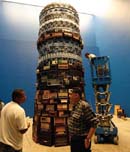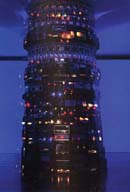Frames, as much as borders, bug Cildo Meireles. That’s why he doesn’t make movies despite the interest he once had in it 40 years ago. The point is films usually end with a similar format and is not a form of art you can enjoy through taste, touch or smell. That also explains why Meireles is not a writer: the alphabet, words are finite… However, the fine arts –not only the visual arts– are to him very powerful, unlimited, free of style and a complete stranger to what he calls “hegemonic scenes.” For instance, Meireles imagines a country so narrow that nobody fits in it, so its citizens are bound to live next to it –like an exiled population. A country so meager everything must be operated from outside. That project serves him to stress his total unfaithfulness in frontiers and speak about scale –one of the motifs seen in his works, which in fact can sport different sizes and harbor countless feelings and possibilities. In Mexico City, at the recently open Collegiate Museum of Contemporary Art (MUAC is the Spanish acronym), is the only venue in Latin America that displays an anthological exhibit by the 61-year-old Brazilian artist that was already shown at the Tate Modern in London –the planner of this exhibition– and the Barcelona Museum of Contemporary Art ( (MACBA). During his visit, the artist watched the detailed rebuilding of each and every artwork, the step-by-step process that breathed life into pieces that today smell, walk, listen, look, hear and touch both children and youngsters. At the Mexico National Autonomous University, Mr. Meireles talked about the evolution and motifs of his works, as well as about today’s arts and the projects he has in store. Frames, as much as borders, bug Cildo Meireles. That’s why he doesn’t make movies despite the interest he once had in it 40 years ago. The point is films usually end with a similar format and is not a form of art you can enjoy through taste, touch or smell. That also explains why Meireles is not a writer: the alphabet, words are finite… However, the fine arts –not only the visual arts– are to him very powerful, unlimited, free of style and a complete stranger to what he calls “hegemonic scenes.” For instance, Meireles imagines a country so narrow that nobody fits in it, so its citizens are bound to live next to it –like an exiled population. A country so meager everything must be operated from outside. That project serves him to stress his total unfaithfulness in frontiers and speak about scale –one of the motifs seen in his works, which in fact can sport different sizes and harbor countless feelings and possibilities. In Mexico City, at the recently open Collegiate Museum of Contemporary Art (MUAC is the Spanish acronym), is the only venue in Latin America that displays an anthological exhibit by the 61-year-old Brazilian artist that was already shown at the Tate Modern in London –the planner of this exhibition– and the Barcelona Museum of Contemporary Art ( (MACBA). During his visit, the artist watched the detailed rebuilding of each and every artwork, the step-by-step process that breathed life into pieces that today smell, walk, listen, look, hear and touch both children and youngsters. At the Mexico National Autonomous University, Mr. Meireles talked about the evolution and motifs of his works, as well as about today’s arts and the projects he has in store. You’ve said a book on Francisco de Goya that you read when you were 12 years old played a fundamental role. How did Goya reel you in exactly? I don’t know. The strength of the drawings, the plastic beauty and the themes, too. A couple of years ago I was in New York and I visited a Goya exhibit at the Frick Collection. It was about the last things he did when he was fleeing from Spain to France, and those were glazed paintings and drawings, very tiny all of them, just an inch by half an inch, six by four, yet as extraordinarily strong as ever. Goya never stops amazing me. Did you ever think of exclusively dedicating yourself to drawing and painting? I started drawing. Goya became a mighty motif for my drawing, but so were the circumstances: drawing is cheap. So, since the age of 15, I started drawing on a regular basis. I studied with Felix Alejandro Barrenechea, a Peruvian who led the Cultural Foundation’s Free Workshop in the Federal District. He was a major figure for me. He developed his artistic career in Lima as a pyrotechnic apprentice and then attended the National School of Fine Arts in Buenos Aires. He came to Belo Horizonte in 1955, married a local, a Brazilian, and then in 1957 he moved to Brasilia where he led the workshop. It was back in 1963, after watching an exposition that came to Brasilia, a very important exhibit in my life, the masks of the University of Dakar collection from Senegal, when I really began to work and work. Work on the arts?< Drawing. I always liked drawing. But following that exhibition I began to take drawing more seriously, to dedicate myself to it indeed. Then in 1965 I made drawings, paintings, though not so much painting at that time. Painting is a religion, a completely different thing. In what sense is painting a religion? It’s an activity with some rituals of its own, with a timing of its own, especially a very different kind of relationship. Drawing is more electric, more instantaneous. It’s a step from the ideal to the materiality. An installation kicks off on a vague idea that later on takes shape, in which everything fits in a particular place, in a size. It’s a slower process. In 1965 a major sculptor traveled to Brasilia, Mario Cravo Junior, who at that time was the head of the Museum of Modern Art in Bahia, Salvador. And when he saw my drawings, he invited me to put on an exhibit. The following year, in January, I made my first personal exhibition. Right after that I traveled to Rio, I was admitted at the National School of Fine Arts in 1968, but I remained there for just a couple of months. I’d already started the Virtual Spaces series, the sketches, the projects, and I decided to move to Paraty, a colonial town rich in World Heritage sites and landmarks, right between Rio and Sao Paolo. That was the city where most of the gold and the diamonds were shipped from Minas Gerais off to Portugal. How did you cut your teeth in the other formats? Because my drawing began as a result of that exposition out of Dakar, for the elegance and the strength of the masks from the African civilizations. Until July 1968 when I moved to Paraty, I wanted to have a change of mind, but my voice was tangled up with other expressionist and figurative stuffs. I felt the need to isolate myself and settle down, as if I were in a biology lab ready to watch a cell. That’s sort of what I did with my ideas. Then a number of factors led me to making use of the Euclidian space model, I mean, a corner (he refers to the Cantos series, meaning Corners), embracing three octagonal projection plains. Following Virtual Spaces, I started working on the Virtual Volumes series, and finally on the Occupations series. From that moment on, my works implied a corporal action of which I’ve concluded three projects until now. I started several projects in the 1970s, including Tiradentes, the monument totem, followed by Insertions in Ideological Circuits. I began Eureka/Blindhotland, Blind Mirror. Those were very productive years and very different things. In 1970, Meireles created Tiradentes, a performance in which he alluded to the torturing and killing of political prisoners, a piece in which ten hens were tied up live to a wooden stake, sprinkled with gasoline and burned to death. Will you be prepared to do something like Tiradentes now? At that moment the army was doing just that to the people, to youngsters in their 20s who were being detained, tortured, killed and maimed. There was fear because people in their 20s were being jailed and murdered by the power of a right-wing, bloodthirsty brigadier who used to tie them up in a place. There was something curious. When I made that piece it was the Tiradentes week and there was an exhibition put on by a museum in Belo Horizonte, the Palace of the Arts, for the celebration of Joaquim Jose da Silva Xavier’s anniversary, a.k.a. Tiradentes, an independence fighter whose body had been tied up to four horses and chopped off to pieces down the streets. The army was trying to get a hold on his figure, the make the most of him because he was a symbol of liberation in Brazil. So, I did that piece because of that too. It was outside the museum, during the exposition’s grand opening. A friend of mine was taking snapshots as I was doing the act, and that’s the only documentation we have of it now. Someone came up to me –I was 22 years old at the time– and asked me, “are you the author of this piece?” I said, “yes.” I was expecting some kind of aggression, but instead he congratulated me. He introduced him and he was the chairman of the Animal Protecting Society in Belo Horizonte. I felt relief because I knew that was a work I wouldn’t do again, yet it was very important to do it at that time. The following day there was a rally full of authorities and politicians, including the President of the Republic, the dictator and everybody from Arena, because they’d symbolically moved the Brazilian capital to Ouro Prieto, where Tiradentes once lived. A news report after that said a congressman delivered a speech right on the spot, blasting the exposition, especially that piece of mine. The journalist wrapped up his report saying that the meal was served right after the speeches, and it was chicken in their own blood. Somewhat ironic, wasn’t it? When and how did you decide to use the arts to answer back to this political context? When in 1967 I started making this geometrical, mathematical thing, I was very interested in tasting that. My works were way too formal, but as far as my condition as a citizen and a student was concerned, I used to join the marches and take part in the confrontations, just like most of my classmates and friend used to do. As to my work, I’d just stepped out of the chaos, I found the way, the path I wanted to take, the one that gave me pleasure. So, I decided to keep my work away from all this dynamics until 1969, shortly after that institutional act whereby the dictatorship banned all civil liberties. It was sheer power. There was an exhibit with artists, sculptors, painters, engravers and architects. That exhibition had been summoned to handpick the Brazilian representation for the Youth Biennial in Paris, and I was one of the guys who were selected. However, a few hours before the exposition, the political police surrounded the museum and the chief of the operation, a colonel, went up to talk with the director of the Museum of Modern Art in Rio, Mauricio Roberto, who was an architect, and he gave him a three-hour deadline to dismount the exposition. He also tried to indict all the participants. That episode led to a tremendous reaction, including an international boycott against the Sao Paolo Biennial. Even Gordon Matta-Clark sent a letter of solidarity with all of us. 1970 was a very productive year for me. I made a number of pieces, and so was in late 1969 when I attended a hall at the Museum of Modern Art in Rio, I grabbed several prizes, including a trip to Paris and New York. I stayed in Rio all through 1970. Many things happened. I made my first exhibit outside Brazil (Information, a collective expo at the MoMA). I was kind of a little worn out at the time, angered, walking away from drawing, with plenty of overdue bills to pay, so I devoted myself to three or four projects. I kept on working on Eureka and Insertions of Anthropological Circuits. The 1970s can be considered as a seminal period. Many things spun off from there and those years were the underpinnings of the work I wanted to develop afterwards. Are the main motifs of your works now the same ones you had then? What are those motifs? I don’t know them. There are certain things I can notice: the space overall, the time that can summarize everything, maybe the scale, that thing standing between the endlessly big things and the endlessly small stuff. Getting down working with materials that serve as symbols and raw materials at the same time. Money is a good case in point, but so are matchboxes, bones, catholic hosts, or reeking gas. I start my work with a familiar thing, something to derive from. I believe it’s also about the… intention of opening the field of the arts to other senses other than the eyes. That’s been very characteristic of Brazilian creation since the late 1950s with the likes of Ligya Clark and Helio Oiticica, two artists who hail from the neo-concetrism. What symbols of the 21st century are you interested in? …there are new symbols, but that’s never a decision, not just like that. It kind of happens naturally. If something comes and turns itself into a piece, into a work. That’s great. If it doesn’t, that doesn’t bother me either. Cinema is an art that, for many, it embraces all the arts. You were very interested in filmmaking back in the 1960s. Are you still interested? You can’t use touch or smell in moviemaking; you can’t taste things, and it depends heavily on electricity. There’s something else that bugs me a little: you have to end in a format. It all began somewhere, nobody cares, but you have to bring it to a close in a format: the film that runs through 24 frames per second. Then, I don’t know how true this assertion really is, I mean, that cinema embraces all the arts. From my standpoint, the fine arts do embrace all the arts, and this is more synthetic. In the fine arts, beginning with a lightning bolt, you can look for the materials, the format, the color. There are no limits because there’s neither a room nor a repertoire that shows you how you must get the thing done. There’s not only one way to do it. In literature, which holds plentiful truth as well, in one way or another you have to work with words. It’s true there are lots and lots of words to choose from, but they are finite. You can’t start a literary play, for instance, by making up all the words. There are people who fit themselves in a certain code of things and proceedings, who cling to a repertoire… The fine arts do allow for that repertoire, unless you reach out to the so-called style, which is the demise of any artist. Style is good for the market, but that’s the end of the road for the artist. Do you write every so often? Yes, I did when I was naïve. But as time rolled on it became harder and harder for me to find ways to express myself in words. Consumption, a topic you’ve used for many of your works, is increasingly defining our societies. What do you make of it? Perhaps this is the final moment, the final stage of industrial capitalism that banks on an absurd principle. If you used to make cars in assembling lines some five or six years ago, and now you keep churning out cars in the same assembling lines and in the same numbers you did in the past, you’ll soon be out of the market because competition forces you to make far more cars each time. There’s no condition of stability in industrial capitalism. No matter what, you just have to make more and more, and sell more and more. But, how much longer will industrial capitalism hinge on that principle of endless growth, because everything on the face of the Earth is huge, but is not endless? If there are no conditions, this is going to explode at anytime. Maybe the worst thing about consumption is its relationship with the continuous expansion of the population. I believe demographics is the root of many of the problems that have begun to hit us hard today. That much is true, it’s a logarithmical growth we’re talking about, rather than a geometrical growth, and food, water and jobs will be scarcer with each passing year, while our problems to manage things will continue to grow as well. In this sense, how do you see Latin America? To me, it’s been quite long since Latin America is an idea in future realization. There was an original population, there were contacts, an invasion –the colonization. So, we share a common colonial past and, therefore, the ideal of Latin American integration is something that could come to pass in the future. I’ve always been bored about this country and frontier thing. We’re all united in only one country called Earth, but the idea of borders, chauvinism has always been very boring to me. I have a project: I want to imagine a country so narrow that nobody fits in it, so its citizens are bound to live next to it –like an exiled population. A country so meager everything must be operated from outside. That has to do with scales. Brazil has always been in a singular position in front of South America because we have historically had three very strong barriers: the Andes, the jungle and the tongue. How do you define yourself as a spectator of the art being created today? I’m not methodic. I’m not when it comes to working and I’m not as a spectator. I enjoy that a lot. I believe in random. I don’t program myself to watch exhibitions, yet there are times when I find things I like a lot; I’m just that lucky. It’s also a nonsystematic relationship. Back in the 1970s I lived traveling between France and Brazil, so in that sense I’d sort of a stroboscopic relationship, like flashing lights, like a rut, a movement, or just when you watch an image in a clipped screen and there are empty spaces to be filled. I seldom go to a place to watch an exhibition or something like that, yet I always wind up finding a few surprises along the way. As far as biennials are concerned, you’ve just taken a piece of yours to the Venice Biennial… Whenever I’ve got a chance I try to attend because that’s a way of recognizing the work of other artists. But I believe the biennials, large-format exhibitions like them, are troublesome because it’s way too hard for the artist to show his or her work appropriately and it’s hard for the spectator to watch. It’s way too much and way too quick. But for the time being it seems everyone wants to stick to that model, I don’t know if it’s all about the lack of other choices or due to easiness. What do you make of today’s art diversity? I think that’s pretty good. I always believe I’m fighting against hegemonic scenes, whenever an art movement becomes the only thing around, and it’s always the same wherever you go. I think art needs plurality, to count on artists dramatically opposite to one another, and all of them working at the same time. Who are the artists you’d like to see? I have a couple of favorite American artists: Chris Burden and Walter de Maria. But there’re others I like very much, like Dennis Oppenheim, Alfredo Jaar, Gabriel Orozco, Francis Alys, Gordon Matta-Clark; I like Argentina’s Victor Grippo, the late Grippo. In Brazil, there are some people I love to watch as well. There’s a very interesting production in the field of the arts, I don’t know all of them, but there’s an opening, an expansion with new contributions to make. Brazil has to reinvent itself, especially after the 1950s because modernism was too committed to a European tradition. The good thing about the Portuguese is that they got mixed with our own, regardless of all the mistakes. A major Brazilian sociologist, Gilberto Frey, used to day the Brazilian culture is on the beds, on the sheets. So, that mixed race –so different to anywhere else around Latin America– is a key player in the definition of art. The youngsters have branched out the arts. Today, Brazil has better, more matured artists, even young talents, doing very different things and I think that’s something good. What works do you have in store? I’m going to a serigraphy exposition. Then to a sound thing about the Brazilian rivers, an invitation from Joao Fernandez, director of the Museum of Contemporary Art of Serralves in Oporto that was supposed to come through in 2008, and finally an exposition at the Queen Sofia Museum in 2011. Do you work in a team? Indeed I must say I’m an individualist. I can’t work if my wife or my children are around… Mechanically, for the execution of something I do need the help of others, but when it comes to coming up with an idea, I need to be on my own. Preferably in a hammock. People don’t believe that you’re definitely working when you are swinging in a hammock. However, lying in a hammock always make lightning bolt happen… The endless possibilities of red; a glassy maze, fences and all kinds of barriers; a motley radio tower; a room where the talc floor caresses the feet, yet the darkness is frightening; a piece so small like a child’s fingernail that cherishes the memory of a myth; the mixture of 27 Beatles songs that hit the top of the charts… They are the pieces: Detour to Red, Throughout, Babel, Volatile, Southern Cross, Liverbeatlespool. The above are some of the pieces included in the Cildo Meireles anthology, no doubt an unforgettable and indispensable exhibit that can be seen in Mexico City all through 2010. the artist would have also wanted to bring Missions, exhibited at London’s Tate Modern, however, budgetary reasons ended up standing in the way. Yet entering this exposition is indeed the best way to cotton on to Meireles’ reasons when it comes to creation: there are no limits for his art, no borders. The artworks are never closed. Cildo Meireles was born in 1948 in Rio de Janeiro. He has authored drawings, plastic actions, huge installations and objects. At the onset of his career, he also worked in set design for plays and movies. He headed the Malasartes magazine. He’s created pieces that reject rationalism and explore the sensorial in a peerless dialogue with the spectator. His works have grabbed such honors as the 2008 Velazquez Fine Arts Award granted by Spain’s Ministry of Culture, and the Ordway Award in the U.S. Through his works, Meireles draws a bead on societies, criticizes or refers to such topics as consumption, myths, communications, geography, repression. He lives and works in Rio de Janeiro. In 2010 in Spain’s Murcia, Cildo Meireles, Francis Alys and six other artists will make a “Cannibal Domino,” a piece curated by Cuauhtemoc Medina for the PAC 2010 Contemporary Art Project. They’ll create pieces based on three axes: remembrance, respect and repetition. Each creator will come up with a project on the basis of the artwork made by his colleague.
























